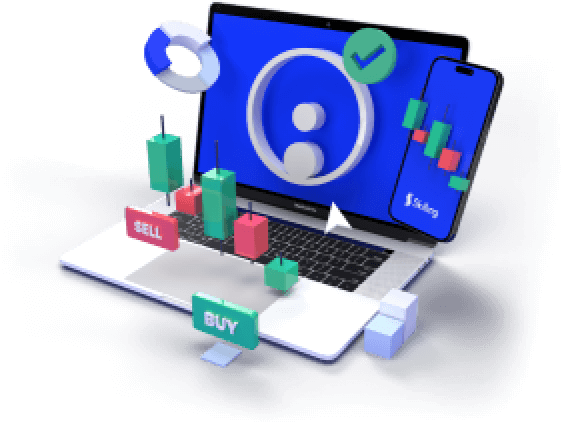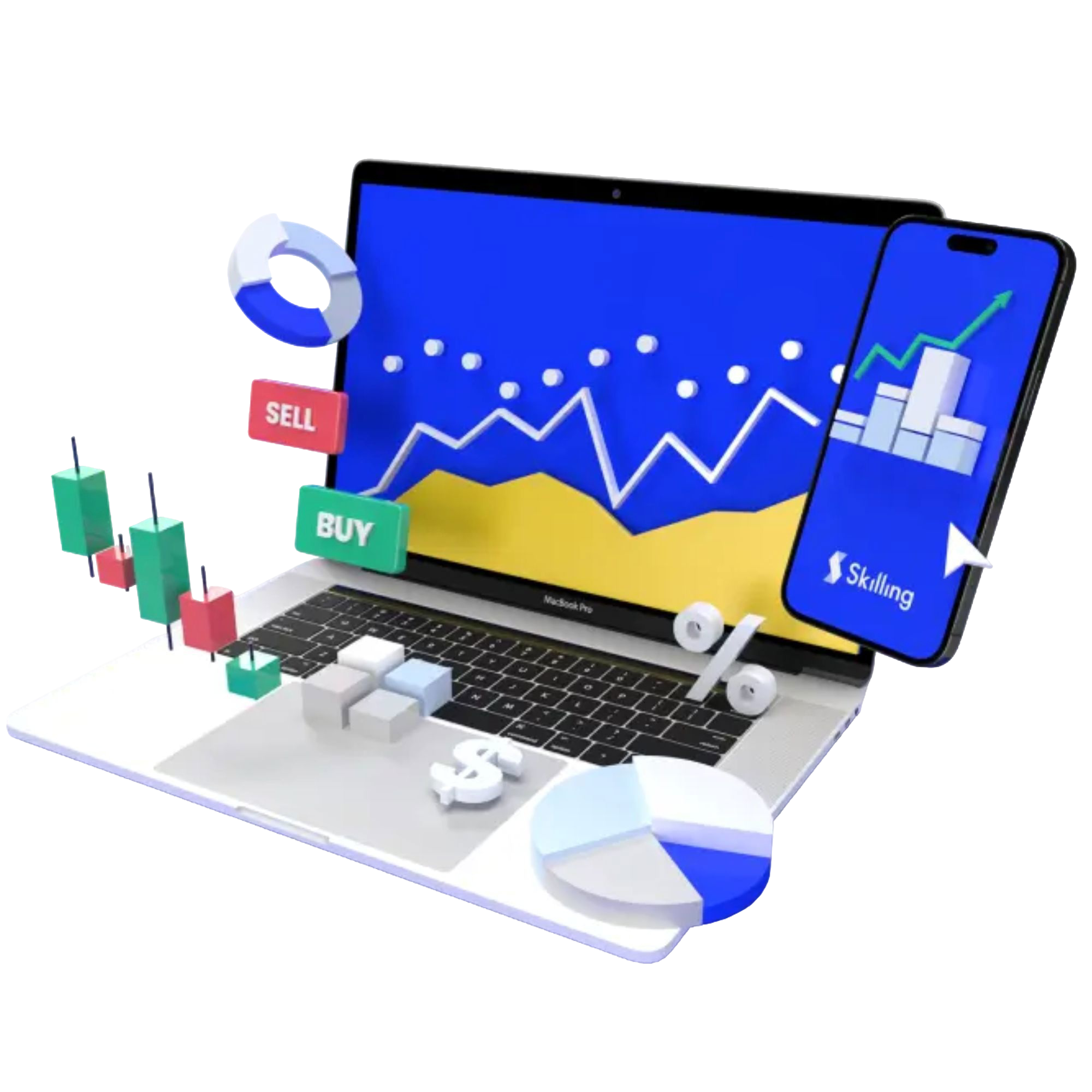Access 1,200+ global CFDs instruments.
Access a plethora of trading opportunities across the financial markets.

Access 1,200+ global CFDs instruments.
Access a plethora of trading opportunities across the financial markets.

Are you new to online trading and wondering how to get started? You may like stocks, cryptocurrencies, Forex, or even commodities like gold. Whichever market interests you, the basics of trading are the same. This guide will walk you through the essential steps you need to know to begin trading, including how to make your first trade. But first, there are certain important things you need to know before you start trading:
Experience Skilling's award-winning platform
Try out any of Skilling’s trading platforms on the device of your choice across web, android or iOS.

How to trade: What you need to know first
Before you learn how to trade, first ask yourself: what are my financial goals and how much time can I dedicate to trading? Knowing your goals will help you make better decisions. Next, get familiar with the basics of trading. This means understanding different assets you can trade, like stocks, cryptocurrencies, Forex, and commodities.
You'll also need to learn some key trading terms such as "bid price," "ask," "spread," and "leverage." Choosing a reliable trading platform is important; look for one that offers good resources and support. Skilling is a reputable and multi-award-winning CFD trading platform that you could consider.
Practice with a demo account to get used to the trading process without risking real money. Learn how to read charts and follow market trends to make smart decisions. Finally, create a clear trading plan that outlines your strategy, risk tolerance, and goals.
Examples of trades
CFD Trading on Bitcoin Price (BTCUSD) Example
Assuming Bitcoin price is currently trading at $60,000, you believe it will rise. You open a long position (buy) with a CFD for 1 Bitcoin at $60,000. If the price increases to $62,000, you sell the CFD and make a profit of $2,000 (1 Bitcoin x $2,000 change). Conversely, if the price falls to $58,000, you would face a loss of $2,000.
CFD Trading on Tesla Shares (TSLA.US) Example
Assuming Tesla shares are currently $200, you think their price will rise. You buy a CFD for 10 shares at $200 each. If the price increases to $210, you sell the CFD and earn a profit of $100 (10 shares x $10 change). If the price drops to $190, you would incur a loss of $100.
CFD Trading on Gold (XAUUSD) Example
Assuming gold - XAUUSD is currently $2,000 per ounce, you expect the price to go up. You open a long position with a CFD for 5 ounces at $2,000 each. If the price rises to $2,020, you sell the CFD and gain $100 (5 ounces x $20 change). If the price drops to $1,980, you would lose $100.
CFD Trading on EURUSD Example
Assuming the EURUSD exchange rate is 1.08177, you believe it will increase. You buy a CFD for 100,000 units (standard position size) at 1.08177. If the rate rises to 1.09177, you sell and make a profit of $1,000 (100,000 units x 0.01 change). If the rate falls to 1.07177, you would face a loss of $1,000.
Research which markets you prefer trading
To research which markets you prefer trading, start by exploring different types of assets like stocks, cryptocurrencies, indices, Forex, and commodities. Look into how each market works, their volatility, and trading hours. Check historical performance, news, and trends to see what interests you and matches your risk tolerance.
What are the risks of trading and how do you manage them?
Before you begin trading, it's important to note that trading involves risk and you could lose money. The main risks include market risk (prices can move against you), leverage risk (borrowing money to trade can amplify losses), and liquidity risk (difficulty in buying or selling assets quickly).
To manage these risks, use a few key strategies:
- Set stop-loss orders: These automatically sell your asset if its price drops to a certain level, limiting potential losses.
- Diversify your investments: Spread your investments across different assets to reduce the impact of one loss.
- Use leverage cautiously: Be careful with borrowing money to trade; only use what you can afford to lose.
- Stay informed: Keep up with market news and trends to make informed decisions.
Trading styles and strategies
Trading styles and strategies help traders decide how to buy and sell assets. Here’s a simple breakdown:
Trading styles
- Day trading: Traders buy and sell assets within a single day, aiming to gain from short-term price movements. They don’t hold positions overnight to avoid risks from after-hours market changes.
- Swing trading: Traders hold assets for several days or weeks to benefit from short-term trends. They look to capture price swings or trends over a few days.
- Position trading: Traders hold assets for months or even years, focusing on long-term trends. They make fewer trades but aim for larger profits based on long-term movements.
- Scalping: Traders make many small trades throughout the day to capture tiny price changes. It requires quick decisions and a lot of trades to build up profits.
What's your Trading Style?
No matter the playing field, knowing your style is the first step to success.

What's your Trading Style?
No matter the playing field, knowing your style is the first step to success.

Trading strategies
- Trend following: Traders buy assets that are trending upwards and sell assets that are trending downwards, aiming to benefit from ongoing market trends.
- Contrarian strategy: Traders go against the market trend, buying when others are selling and selling when others are buying, based on the belief that the market is overreacting.
- Technical analysis: Traders use charts and technical indicators to predict future price movements based on historical data and patterns.
- Fundamental analysis: Traders analyze financial and economic factors (like company earnings or economic reports) to determine the value of an asset and make trading decisions.
Each style and strategy has its approach to risk and gains, so choosing the right one depends on your goals and trading preferences.
Creating a trading plan
Creating a trading plan is like setting rules for how you will trade to help you stay focused and make better decisions. Here’s how to create one:
- Set your goals: Decide what you want to achieve with your trading. Are you looking to make a certain amount of profit or grow your investment over time?
- Choose your trading style: Pick a style that suits your lifestyle and goals, like day trading, swing trading, or long-term investing.
- Select markets and assets: Decide which markets (stocks, cryptocurrencies, etc.) and assets you want to trade based on your interests and research.
- Define your risk management: Set rules for how much you’re willing to risk on each trade. Use stop-loss orders to limit losses and protect your capital.
- Plan your entry and exit points: Decide when you will buy or sell assets. This can be based on technical analysis, market trends, or other strategies.
- Review and adjust: Regularly check how your trading plan is working. Make adjustments based on your performance and changes in the market.
By following a trading plan, you can stay organized, avoid emotional decisions, and increase your chances of success.
Practice with a Demo Account
Try our demo account and experience real market conditions.

Begin your trading experience with a demo account then you can open a live account
To start trading, it's a good idea to begin with a demo account before moving to a live account. Here’s how it works:
- Start with a demo account: A demo account lets you practice trading using virtual money. It simulates real market conditions but doesn’t involve actual money. Use it to get comfortable with the trading platform, test your strategies, and learn how trading works without risking your funds.
- Open a live account: Once you feel confident and ready, you can open a live account. This involves using real money to trade. Be sure to start with a small amount that you can afford to lose, and apply the skills and strategies you practiced with the demo account.
Starting with a demo account helps you gain experience and confidence, making the transition to live trading smoother and safer.
Conclusion
As you've seen, trading is not for everyone and it requires a solid understanding of the markets, careful planning, and a disciplined approach. It involves choosing the right trading style, managing risks effectively, and constantly staying informed about market trends. Whether you're using a demo account to practice or moving to live trading, success comes from being well-prepared and making informed decisions. By developing a clear trading plan and sticking to it, you could navigate the complexities of trading and work towards achieving your financial goals. Source: ig.com
Enjoyed the content? Open a free Skilling trading account today and access 1200+ global assets such as stocks, cryptocurrencies, Forex, commodities and indices with very low spreads and fees.











